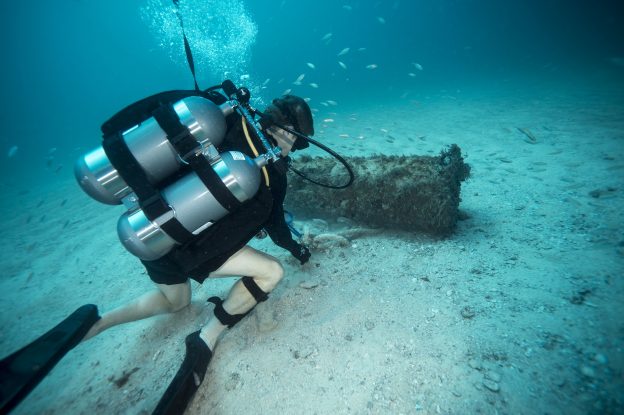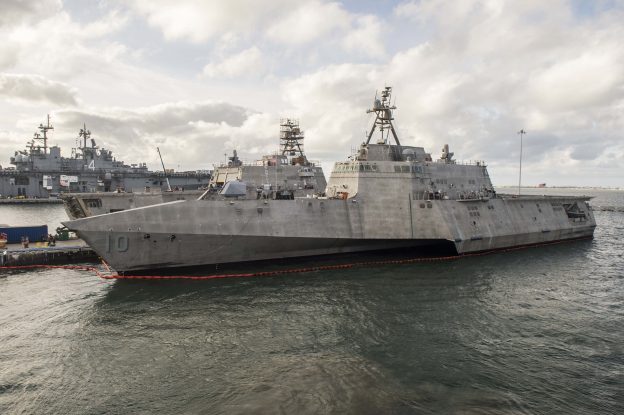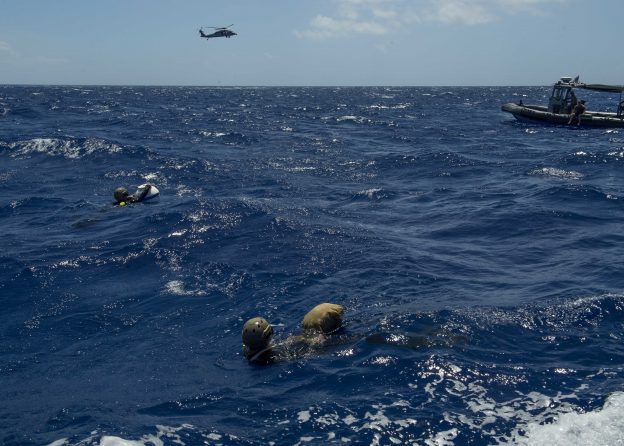The Navy is moving to further divorce mine warfare capabilities from specific platforms, going even beyond the modular setup of the Littoral Combat Ship.

Petty Officer 2nd Class John Christner assigned to Commander, Task Group 56.1 (CTG 56.1), Explosive Ordnance Disposal Mobile Unit One, embarked aboard RFA Lyme Bay (L 3007), examines an inert mine training shape on Oct. 15, 2016, during UK/US Mine Countermeasures Exercise 2017 (UK/US MCM-Ex 17). US Navy photo.
The service already moved away from legacy equipment, which paired mine-hunting and mine-neutralizing gear with dedicated Avenger-class mine countermeasure ships and MH-53E Sea Dragon helicopters. The Littoral Combat Ship created a new dynamic, where a prepackaged kit of MCM tools could be installed on the ship, or it could be taken off and swapped wholesale for a mission package for a different warfare area.
Now, according to Director of Expeditionary Warfare Maj. Gen. David Coffman (OPNAV N95), that mission package will be deconstructed. Instead of aiming to deliver to operational commanders a cookie-cutter set of MCM tools in a box, the Navy will focus on developing sensors and effects that are applicable to mine warfare; that can be mixed and matched with various manned or unmanned offboard vehicles; and that are employed from an LCS, from ashore or from other vessels of opportunity.
As an example, a key piece of the mine-hunting capability today is the Knifefish unmanned underwater vehicle with its synthetic aperture sonar. While it has performed well in testing, officials have previously told USNI News that the UUV itself is limited in endurance and may not be able to operate in areas of the world with strong underwater currents. However, with this piece of gear, the sonar and the UUV are a package deal, meaning an operational commander’s hands are tied in certain areas of the world.

USS Gabrielle Giffords (LCS-10) is pierside at Naval Base San Diego and preparing to conduct final contract trials (FCT) in 2017. US Navy Photo
Going forward, Coffman said, the Navy would prioritize the development of families of unmanned air, surface and undersea vehicles – not built for any specific mission set – with known performance parameters, towing capacities, space for sensor packages and other specifications. An operational commander could then select the right unmanned vehicle, select the sensor or effects package needed for the mission, and tailor that combination for the physical environment and threat environment he faces.
On the one hand, this approach frees up the Navy to field bits of capability as technology evolves, rather than waiting for a whole package of equipment to all be ready. The Navy previously broke its LCS mission packages up into increments, to address a widening gap in expected fielding timelines for the pieces of the package. As warfighters are constantly asking to experiment with the latest and greatest gear, moving away from the idea of a mission package altogether may increase the ability to put new sensors out into the field for demonstrations and experiments faster.
On the other hand, the MCM community already struggled to get sufficient funding in the Navy budget request – and then keep that funding as the budget went through Congress – and deconstructing the mission packages into individual sensors or unmanned vehicles runs the risk of exacerbating the funding challenges.
“It’s a typically historically under-resourced warfare area. It does not have a strong ownership of governance in terms of people waking up every day saying, we are going to work on this,” Coffman said.
“I think it’s going to be very challenging. … The services, Washington, Congress, everybody’s choking a little bit on this divorce of platforms, payloads, sensors. The system tends to like, ‘I bought one of these and one of these and it does this one thing.’ In mine warfare, as I’ve articulated, our thesis is that’s definitely not the right approach for this warfare area. … That typically doesn’t translate well in the rough world of the marks” to the budget request.

U.S. contractors with the Navy Mine Hunting Unit (MHU) depart the well deck of the RFA Lyme Bay (L3007) to test a common unmanned surface vehicle (CUSV) in the Arabian Gulf as part of U.K.-U.S. Mine Countermeasures Exercise 17-1 on Nov. 15, 2016. US Navy photo.
Despite the potential drawback of having to work even harder to help the Navy, the Defense Department and Congress understand an even more complex budget request, Coffman said the total decoupling of capabilities from offboard vessels from ships and aircraft is a natural move that was bound to happen as the LCS program matured.
“When you start the program, you’ll say, I need 24 MCM mission packages, and they’re each going to have this, this, this, this and this,” he said.
“And then when you do your exercises and your experiments, you’ll overlay an environmental and they’re like, 7th Fleet will say, ‘why are you sending that over here? That stuff doesn’t work either in my threat environment or my environmental environment.’ So we’re going to have to move from the idea of nascent programs to the real world of operational employment.”
He likened the deconstructed mission packages to his time leading Marine Corps units.
“Warfighting has always been a mix-and-match capability. So when I’ve been a commander at the [Marine Expeditionary Unit] and [Marine Expeditionary Brigade] level and supporting the [Marine Expeditionary Force]-level commanders, you have the diversity of your portfolio. So you find the [capabilities] and [limitations] across those portfolios” and use people and gear to best accomplish your mission, without having any kind of homogenous pre-packaged answer available.

Sailors assigned to Explosive Ordnance Disposal Mobile Unit (EODMU) 5 conduct floating mine countermeasures training in the Philippine Sea, May 2, 2018. EODMU-5 is assigned to Commander, Task Force 75, the primary expeditionary task force responsible for the planning and execution of coastal riverine operations, explosive ordnance disposal, diving engineering and construction, and underwater construction in the U.S. 7th Fleet area of operations. US Navy photo.
Just as the Navy intends to separate the sensors from the manned and unmanned vehicles that carry them – the Common Unmanned Surface Vehicle, the MH-60S manned helicopter and the MQ-8 Fire Scout unmanned helicopter, among them – so too is the Navy trying to separate these offboard vehicles from the LCS.
Coffman acknowledged the Navy would still deploy LCSs with mission packages and acknowledged that the Program Executive Office for Unmanned and Small Combatants – formerly PEO LCS – would still oversee the development of many of these sensors and offboard vehicles.
“But, we are not going to have the mine warfare mission area hostage to LCS as unique, only, primary platform,” he said.
As the mine warfare community branches out from the LCS as a host platform, it is looking for closer ties to the Expeditionary Sea Base, like USS Lewis B. Puller(ESB-3) operating in the Middle East today – whose original mission set was to serve as an afloat staging base for mine warfare operations but instead has forged closer relationships with the special operations community and the Marines Corps’ land-based units serving in U.S. Central Command.
Coffman called the Puller-class a “high-quality afloat forward staging base for mine countermeasures and other mission sets, but really trying to strengthen the hand in terms of their mine warfare interface.”
news.usni.org